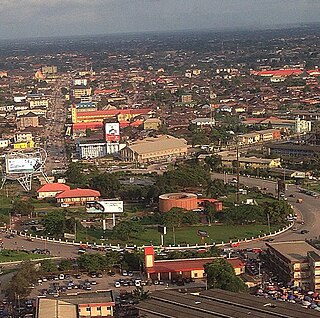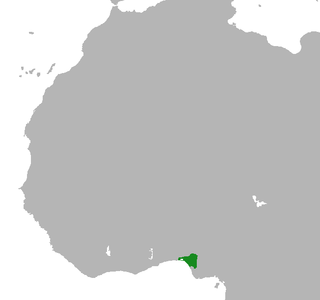Related Research Articles

Benin City is the capital and largest city of Edo State, southern Nigeria. In central Kings square, the Benin city National Museum traces the Benin empire and has displays of terracotta sculpture. The Oba's palace is known for bronze plaques that once decorated with the walls, depicting historical events and Life at court. It is the fourth-largest city in Nigeria according to the 2006 census, after Lagos, Kano, and Ibadan. It is situated approximately 40 kilometres (25 mi) north of the Benin River and 320 kilometres (200 mi) by road east of Lagos. Benin City is the centre of Nigeria's rubber industry, and oil production is also a significant industry.

The Oba of Benin is the traditional ruler and the custodian of the culture of the Edo people and all Edoid people. The then Kingdom of Benin has continued to be mostly populated by the Edo.

Alaafin, or The custordian of the Palace in the Yoruba language, is the title of the king of the medieval Oyo empire and present-day Oyo town of West Africa. It is the particular title of the Oba (king) of the Oyo. It is sometimes translated as "emperor" in the context of ruler of empire. He ruled the old Oyo Empire, which extended from the present-day Benin republic to Nigeria, originating from states in the South East and West to the North. The people under him are called Yoruba people and spoke the Yoruba Language.

Ewuare was the Oba (king) of the Benin Empire from 1440 until 1473. Ewuare became king in a violent coup against his brother Uwaifiokun which destroyed much of Benin City. After the war, Ewuare rebuilt much of the city of Benin, reformed political structures in the kingdom, greatly expanded the territory of the kingdom, and fostered the arts and festivals. He left a significant legacy and is often considered the first King of the Kingdom of Benin.
Ọ̀rànmíyàn, also known as Ọ̀rányàn, was a legendary Yoruba king from the kingdom of Ilé-Ifẹ̀, and the founder of the Oyo empire. Although he was the youngest of the descendants of Oduduwa, he became the prime heir of Oduduwa upon his return to claim his grandfather's throne.

Oba Esigie was the son of Oba Ozolua, who reigned in the late 15th century, and his second wife, Queen Idia. Oba Esigie ruled the ancient Benin Kingdom, now Benin City, Edo State, Nigeria. Works of art commissioned by Esigie are held in prominent museums including the Metropolitan Museum of Art and the British Museum.
Oba means "ruler" in the Yoruba and Bini languages. Kings in Yorubaland, a region which is in the modern republics of Benin, Nigeria and Togo, make use of it as a pre-nominal honorific. Examples of Yoruba bearers include Oba Ogunwusi of Ile-Ife, Oba Aladelusi of Akure, and Oba Akiolu of Lagos. An example of a Bini bearer is Oba Ewuare II of Benin.
Igueben is a local government area of Edo State, Nigeria. Its headquarters are located in the town of Igueben, which has an area of 380 km2 (150 sq mi) and a population of 69,639 according to the 2006 census. The postal code is 310.

The Kingdom of Benin, also known as the Edo Kingdom or the Benin Empire, was a kingdom within what is now southern Nigeria. It has no historical relation to the modern republic of Benin, which was known as Dahomey from the 17th century until 1975. The Kingdom of Benin's capital was Edo, now known as Benin City in Edo State, Nigeria. The Benin Kingdom was "one of the oldest and most developed states in the coastal hinterland of West Africa". It grew out of the previous Edo Kingdom of Igodomigodo around the 11th century AD, and lasted until it was annexed by the British Empire in 1897.
Igodomigodo is the original name of the Benin Empire used by its own inhabitants.
The Kingdom of Ugu is a kingdom that exists in Nigeria, in what is now Edo State. The Edo State is also called Benin, though it is not to be confused with the country. The Kingdom of Ugu originated out of Igodomigodo in Nigeria.
Ode Usen, also known as Ufe kekere and Ode Awure is the name of a small town in Edo state, Nigeria. It also doubles as the name of a Yoruba subgroup consisting of culturally related villages situated between Ofosu in the west and Ogbese in the east. Usen is surrounded on all sides by smaller villages and farmsteads known in the local Yoruba dialect as Egunre. some of the villages under the authority of Usen include; Arere, Oladaro, Arekpa, Ogunweyin, Ogidigbo, Ilorin (Ulorin), Ukankan, Ajegunle, Obomen, Aghakpo, Leleji, Ofaran, Okeodo, Adeyanba. These villages were all founded by people from Usen and speak the same dialect of the Yoruba language. There are also other communities that speak the same dialect of the Yoruba language as Usen, but are not within its political auspices such as Igue Ogho between Ekiadolo and Usen.
Ezomo of Benin is a title held by the supreme war chief in the ancient Benin Kingdom. The chief with the Ezomo title is the 3rd highest ranking chief in the Benin Kingdom. The title was initially awarded to any notable warrior in the Kingdom by the Oba of Benin. However, during the reign of Ezomo Ehenua, the Oba of Benin Kingdom, Oba Akenzua I, made the title hereditary to the Ehenua family. The Ezomo is known to live in Uzebu in a semi-independent state.
Ada and Eben are sceptres which represent symbols of authority in the ancient Benin Kingdom. Ada, which represent a `sword of honour` and Eben which represent a `sword for dancing` were introduced to the Benin Monarchy system during the Ogiso Ere dynasty. Both sceptres are mainly used for authority proclamation and ceremonial activities. The Ogiso Ere dynasty introduced Ada and Eben around16 A.D. - 66 A.D. The Ada appears to be superior to the Eben as it is held by the Oba of Benin Kingdom. However, it can sometimes be delegated to any senior Chief in the Kingdom such as the Esama and Enogie. Whereas, the Eben is often held by titled chiefs in Benin Kingdom.
The ancient gates of Benin Kingdom were the nine access point into the Kingdom of Benin, in what is today known as Benin City. The city is known to be surrounded by wide inner walls made of earthwork and moats. In the 1974 edition of the Guinness Book of Records, it described the Benin City walls as the largest earthwork carried out before the Mechanical period. Part of the walls were believed to be about 65 ft (20 m) tall. The ancient walls in the Benin Kigdom were transformed to the access point or gates to the city. These gates include Iya Uzebu, Iya Osuan, Iya Urh'Ogba, Iya Ivbiyeneva, Iya Uhunmwun Idunmwun, Iya Akpakpava or Iya Ok'Edo, Iya Ewaise, Iya Ero, and Iya Isekhere.
Igun Street, also known as Igun-Eronmwon Quarters, is a street situated in Benin City, Edo State, Nigeria. This street is renowned for being the residence of the Guild of Benin Bronze and Brass Casters, known as the Igun-Eronmwon. It holds the designation of a UNESCO World Heritage Site. Notably, it stands as the second most frequented tourist attraction within Benin City. Tourists, art dealers, and collectors routinely visit Igun Street to observe the comprehensive process involved in crafting these objects.
Eweka I was a monarch in the history of the Benin Kingdom, overseeing an era during the transition from the Ogiso Dynasty to the Obaship. His 35-year reign had a notable impact on the political, cultural, and traditional aspects of the kingdom.

The Igbesanmwan is a hereditary guild of ivory carvers in the Benin Kingdom, a pre-colonial African state located in present-day Edo State, Nigeria. Members of the Igbesanmwan guild hold the responsibility of crafting ivory items, including masks, tusks, staffs, leopards, and various other symbols denoting royal authority and eminence, for the Oba (king) and the royal court. In addition to their ivory craftsmanship, the Igbesanmwan possess proficiency in working with a range of other materials, such as wood, brass, and coral. This guild is recognised as one of the most ancient and esteemed in Benin, with their artistic work being widely appreciated for its aesthetic appeal and technical mastery.

Ewedo, originally known as Prince Efabo, was the fourth Oba of the Kingdom of Benin who reigned from 1255 AD to 1280 AD. He was the only son and successor of Ehenmihen. He is credited with moving the seat of his government from Usama to the present palace site, introducing various gods and laws, and changing the name of the country from Ile or Ile-Ibinu to Ubini (Benin). He also reformed the political and administrative system of the kingdom, established a palace bureaucracy, and expanded the territory and influence of Benin.
References
- ↑ "Oba's coronation: Uzama Palace gets facelift | The Nation Newspaper". 2016-10-11. Retrieved 2023-01-25.
- ↑ "THE UZAMA (King Makers)". www.edoworld.net. Retrieved 2023-01-25.
- ↑ "Analysis of the Uzama Titles". www.edoworld.net. Retrieved 2023-01-25.
- ↑ "Highest Ranking Chiefs of the Benin Kingdom - Uzama, Oliha, Oyo, and Ife". edofolks.com. Retrieved 2023-01-25.